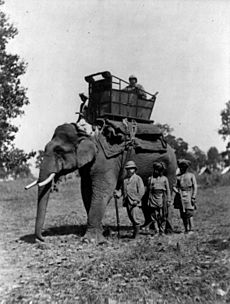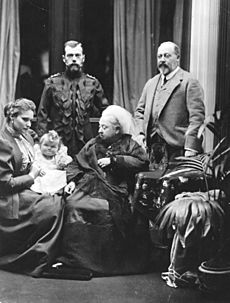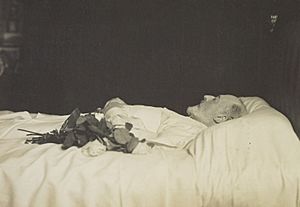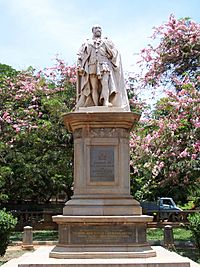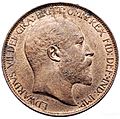Edward VII facts for kids
Quick facts for kids Edward VII |
|||||
|---|---|---|---|---|---|

Portrait by W. & D. Downey, 1900s
|
|||||
|
|||||
| Reign | 22 January 1901 – 6 May 1910 | ||||
| Coronation | 9 August 1902 | ||||
| Imperial Durbar | 1 January 1903 | ||||
| Predecessor | Victoria | ||||
| Successor | George V | ||||
| Born | 9 November 1841 Buckingham Palace, London, England |
||||
| Died | 6 May 1910 (aged 68) Buckingham Palace, London, England |
||||
| Burial | 20 May 1910 Royal Vault, St George's Chapel, Windsor Castle
|
||||
| Spouse | |||||
| Issue Detail |
|||||
|
|||||
| House | Saxe-Coburg and Gotha | ||||
| Father | Prince Albert of Saxe-Coburg and Gotha | ||||
| Mother | Queen Victoria | ||||
| Religion | Protestant | ||||
| Signature | |||||
| Education | |||||
Edward VII (born Albert Edward; 9 November 1841 – 6 May 1910) was the King of the United Kingdom and the British Dominions. He was also the Emperor of India. He ruled from 22 January 1901 until his death in 1910.
He was the second child and oldest son of Queen Victoria and Prince Albert. Edward was known as "Bertie" to his family. He was related to many royal families across Europe. He was the Prince of Wales and the next in line to the British throne for almost 60 years.
Contents
Edward's Early Life and Schooling
Edward was born at Buckingham Palace on 9 November 1841. He was the oldest son of Queen Victoria and Prince Albert. He was named Albert Edward when he was christened. His family called him "Bertie".
As the Queen's oldest son, he became the Duke of Cornwall and Duke of Rothesay when he was born. He was also made Prince of Wales on 8 December 1841. In 1863, he gave up his right to become the Duke of Saxe-Coburg and Gotha. This title went to his younger brother, Prince Alfred.
Queen Victoria and Prince Albert wanted Edward to have a good education. They wanted him to be a model constitutional monarch. Edward started a strict school program at age seven. He had many teachers. He did not do as well in his studies as his older sister, Victoria. Edward was charming and friendly, but not a very hard-working student.
After a trip to Rome in 1859, Edward studied at the University of Edinburgh. In October, he went to Christ Church, Oxford. He enjoyed studying for the first time there. In 1861, he moved to Trinity College, Cambridge. He studied history with Charles Kingsley.
Edward's Young Adult Years
In 1860, Edward took his first trip to North America as Prince of Wales. He was friendly and confident, which made the trip a big success. He opened the Victoria Bridge, Montreal, and laid the first stone for Parliament Hill, Ottawa. He watched Charles Blondin walk across Niagara Falls on a highwire. He also stayed with President James Buchanan at the White House.
Edward visited Mount Vernon to honor George Washington. Large crowds greeted him everywhere. He met famous writers like Henry Wadsworth Longfellow. This four-month trip helped Edward feel more confident. It also helped improve relations between Britain and other countries.
Marriage and Family
Edward married Princess Alexandra of Denmark in 1863. He was 21 years old, and she was 18. They had six children together.
As Heir to the Throne
While Queen Victoria was a widow, Edward started the idea of royal public appearances. He opened important places like the Thames Embankment in 1871. He also opened the Mersey Tunnel in 1886 and Tower Bridge in 1894. However, his mother did not let him have a big role in running the country until 1898. He received summaries of government papers, but not the original documents.
On 26 September 1875, Edward went on a long eight-month trip to India. He also visited Malta, Brindisi, and Greece. His helpers noticed that he treated everyone the same, no matter their social class or skin color. He wrote home about how British officials treated native Indians. He said, "Because a man has a black face and a different religion from our own, there is no reason why he should be treated as a brute." He returned to England on 11 May 1876. After his trip, Queen Victoria was given the title Empress of India. This was partly because his tour was so successful.
Edward was seen as a leader in men's fashion around the world. He made tweed clothes, Homburg hats, and Norfolk jackets popular. He also made it fashionable to wear black ties with dinner jackets. He started the tradition of eating roast beef and potatoes with horseradish sauce and Yorkshire pudding on Sundays. This meal is still a favorite British Sunday lunch.
Edward supported the arts and sciences. He helped start the Royal College of Music. He opened the college in 1883. He also enjoyed gambling and country sports like hunting. He ordered all the clocks at Sandringham to be half an hour ahead. This gave more daylight time for shooting. This tradition, called Sandringham Time, lasted until 1936. He also built a golf course at Windsor. By the 1870s, he was very interested in horse racing. In 1896, his horse Persimmon won two big races. In 1900, another of his horses, Ambush II, won the Grand National.
In late 1891, Edward's oldest son, Albert Victor, got engaged. Just a few weeks later, in early 1892, Albert Victor died from pneumonia. Edward was very sad. He wrote that losing his oldest son was a "calamity one can never really get over." Albert Victor was the second of Edward's children to die. In 1871, his youngest son, Alexander John, died just 24 hours after being born.
Edward's Time as King
When Queen Victoria died on 22 January 1901, Edward became King of the United Kingdom. He also became Emperor of India and King of the British Dominions. He chose to be known as Edward VII, not Albert Edward.
As king, Edward helped make the British Home Fleet more modern. He also helped reorganize the British Army after the Second Boer War (1899–1902). He brought back traditional ceremonies as public events. He also made royalty socialize with a wider range of people. He worked to build good relationships between Britain and other European countries, especially France. Because of this, people called him "Peacemaker." However, his relationship with his nephew, German Emperor Wilhelm II, was not good.
The Edwardian era was named after Edward's reign. This time saw big changes in technology and society. These included new types of engines and the rise of new political ideas. Edward died in 1910 during a political crisis. This crisis was solved the next year by the Parliament Act 1911. This act limited the power of the House of Lords. Edward's only surviving son, George V, became king after him.
The "Uncle of Europe"

Edward was related to almost every other king and queen in Europe. People called him the "uncle of Europe." German Emperor Wilhelm II and Emperor Nicholas II of Russia were his nephews. Many other queens and princesses were his nieces. King Haakon VII of Norway was both his nephew and his son-in-law. Edward loved his grandchildren and spoiled them. However, Edward did not like Wilhelm II. Their difficult relationship made tensions worse between Germany and Britain.
In April 1908, Edward accepted the resignation of the British Prime Minister, Sir Henry Campbell-Bannerman. Edward asked the new Prime Minister, H. H. Asquith, to travel to Biarritz to meet him. This was unusual, and the newspapers criticized the King for appointing a prime minister outside Britain. In June 1908, Edward became the first British monarch to visit the Russian Empire.
Edward's Death
Edward suffered from bronchitis more and more as he got older. In 1907, a type of skin cancer near his nose was treated. In February 1909, he briefly lost consciousness during a visit to Berlin. In March 1910, he collapsed while staying in France. The King's poor health was not reported to the public. He returned to Buckingham Palace on 27 April, still very ill.
On 6 May, Edward had several heart attacks. He refused to go to bed, saying, "No, I shall not give in; I shall go on; I shall work to the end." His son, the Prince of Wales (who would soon be King George V), told him that his horse had won a race that afternoon. The King replied, "Yes, I have heard of it. I am very glad." These were his final words. He died 15 minutes later.
His funeral was held on 20 May 1910. It was called "the greatest gathering of royalty and important people ever seen." Edward was buried at St George's Chapel, Windsor Castle.
Edward's Legacy
Before becoming king, Edward was the longest-serving heir to the British throne. His great-great-grandson Charles III later held this record. Edward was also the longest-serving Prince of Wales.
As king, Edward VII was more successful than many people expected. He was already older when he became king, so he did not have much time to rule. In his short reign, he made sure his second son and heir, George V, was better prepared to be king. Edward and George were very close, like brothers. When Edward died, George wrote in his diary that he had lost his "best friend and the best of fathers."
Edward is seen as the first truly constitutional British sovereign. This means he ruled with limits set by law. He was called "Peacemaker" because he tried to improve relations with other countries. However, he worried that his nephew, German Emperor Wilhelm II, would start a war in Europe. Four years after Edward's death, the First World War began. Wilhelm II blamed Edward for the war.
Images for kids
-
London Bridge on the Night of the Marriage of the Prince and Princess of Wales, by William Holman Hunt (1864)
-
Bust by Francis Derwent Wood
-
Profile of Edward VII on a halfpenny, 1902
See also
 In Spanish: Eduardo VII del Reino Unido para niños
In Spanish: Eduardo VII del Reino Unido para niños




